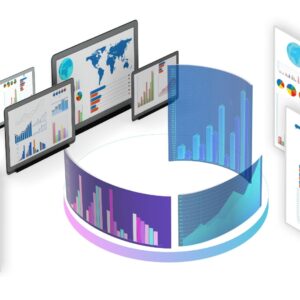The sales forecast is the foundation for virtually any business growth opportunity. Increasing sales revenue, reducing costs, creating ROI, and attracting customers and investors are all possible with better, more efficient forecasting practices.
Predicting future sales does not demand advanced knowledge or creativity. Any sales manager can develop sound sales forecasts with motivation and effort. Sales forecasts are primarily educated guesses, which can be refined and reinforced with more information.
If you are new to sales forecasts, there are plenty of quality resources to get you started. Most sales forecasting comes from tried-and-true methodologies that fit a variety of business models.
This guide will help you create effective sales forecast strategies. You will learn tips on optimizing your sales forecasting methods and be given examples that you can apply to grow your business.
What is Sales Forecasting?
A sales forecast is an essential component of your business plan. Sales forecasting is an educated estimate of expected sales revenue within a particular period. Short-term forecasts may be done quarterly while long-term forecasts may outline the next three to five years. Forecasting terms are primarily dependent on your unique business goals.
Accuracy is a central concern, though sales forecasting is an imperfect science. Putting together a sales projection relies on a blend of sales data and business intuition. Personal experience goes a long way in interpreting data and predicting future results.
Projections bring together data points and insights surrounding several factors. These include target customers, decision-making processes, the solutions you sell, how those solutions are being used, and why customers seek out your solutions. Answering the who, what, when, why, and how with richer data and more experience is a fundamental key in creating usable sales forecasts.
When sales forecasts are accurate and detailed, businesses benefit in several ways. Managers can set better budgets based on anticipated business and allocate resources to meet demand. They can generally make better production, distribution, marketing, and sales decisions.
 How to Forecast Sales?
How to Forecast Sales?
A sales forecast is a prediction of how much business you plan to generate and when. Forecasting data can come from competitive analysis, past performance, or large market data such as national industry sales. Depending on the information you have available, there are several bottom-up and top-down sales forecast methods you can apply.
Startups and young businesses often do not have historical data to pull from, so they must rely on market information. Finding similar businesses in terms of size, product offerings, and target market is a good place to start. Using information like average price, annual sales, and sales volume can help you estimate what you can reasonably expect.
Once you have established your business, you can use your past performance to predict future results. How you define your sales forecast depends on how well you understand your sales cycle and sales process. These should be based on the buyer’s journey.
When you have a formal process defined, you can more accurately predict how deals will play out. This helps you scale operations as you anticipate changes from seasonal buying, product launches, or external factors affecting markets. Adherence to processes also highlights challenges to address within the sales cycle stages.
Lead-Based Forecasting
B2B sales base much of their sales activities on how they generate leads. Sales can be forecasted by estimating how many initial contacts a sales rep makes daily.
As an example, you may find that a sales rep averages X phone calls per day. You can then look at how many meetings and follow-ups they schedule from those calls. Out of those meetings, how many results in sales?
You can start to predict the end of the sales cycle by looking at the beginning through reasonable success rates. A percentage of sales calls results in a meeting. A percentage of meetings results in a close.
Obviously, there can be more steps. The point is that these calculations can help predict sales based on the number of leads.
Comparing to a Top-Down Approach
A top-down approach takes the total market and estimates sales based on your anticipated share. For example, if you are a furniture retailer, you may operate in a market worth $200 million annually. You anticipate a percentage of the market share and arrive at your forecasted number.
This is an oversimplification as you need to account for your capacity, customer buying habits, and other factors. However, the key concept is that you start with a large number and break it down to your share.
As a standalone sales forecast method, the top-down approach is largely conjecture-based and unreliable. When used alongside bottom-up approaches like historical review and lead-based forecasting, it helps to check your accuracy. If your top-down and bottom-up approaches align, you can feel fairly confident in your estimate. If they differ greatly, you may have missed a key variable.
Reviewing Data and Reformulating Strategies
A bottom-up approach is perfect for an interactive and evolutionary approach to forecasting. If you plan for X amount of sales, but you are actually generating Y, you can adjust it. Revisiting your forecasts regularly is an important part of maintaining reasonable expectations.
Reviewing and tweaking your sales forecasting is helpful when managing growth. As you gain more insight and data, you can better answer key questions surrounding your forecasting. This will result in more relevant measures and forecasting focus.
Some Essential Tips in Creating an Effective Sales Forecast
When you set up sales forecasts in a business plan, you need the information to be relevant and actionable. Here are some essential tips for creating an effective sales forecast.
Find factors for new product forecasts
New products depend on educated guesses because there are no former cases to lean on. For accuracy, you can use similar products supplied by you or a close competitor as a benchmark.
If this is the next model in a series, you can look at previous versions to see how your customers bought the product. When you are introducing a completely new concept, you can look at past solutions. What solutions did customers previously use to accomplish what your new product accomplishes? Use that data to predict adoption rates.
Use historical data
Of all sales forecast tools, recent sales information is the most objective insight for future sales predictions. Look at your past annual sales, reviewing as far back as possible to identify patterns. Through data analysis and intuition, you can predict upcoming sales numbers with a degree of confidence.
Develop a unit sales projection
Most businesses measure their sales by the number of units moved. For product-based companies, this makes obvious sense. For example, auto manufacturers look at the number of cars sold.
Even service companies can define how they make money in terms of units. Lawyers offer their services by the hour. SaaS developers may review subscriptions each month. Establishing clearly defined units makes performance measuring and forecasting much easier in most cases.
Define unique factors behind sales
Sales forecasts will look different for each business due to their industry, customer base, and unique offerings. The variables and calculations you use to predict future sales will be specific to your business.
Let’s say you run a furniture store. You may look at the number of customers you get during different days of the week. Take the average revenue generated per customer and project what you may make on a given Saturday.
Forecast prices
Projected costs are as impactful on your growth as projected sales numbers. This includes both prices you set and prices you pay.
As you set up a forecasting spreadsheet, you need to input your pricing estimation. This is multiplied by expected unit sales to return your projected revenue. Projecting the unit sales is the research-heavy portion of this equation as you control pricing.
Identifying costs, supplier prices, and sales investments are what is needed to calculate margin. What does your business actually earn to propel future business? Without accounting for future sales costs, you will likely be disappointed by your actual gains.
5 Sales Forecast Examples
There are a lot of resources and reliable templates available online to facilitate your sales forecasting setup.
The following are five sales forecast examples that can be applied to modern business strategies:
Quarterly Budget Sales Template
Small businesses with simple accounting can manage all of their expenses versus sales in this straightforward template. This sales forecast template helps see changes from one quarter to the next.
With sales being needed to pay for expenses, it shows how you can reasonably expect to sustain current operations. By breaking down quarterly costs, overspending and areas of opportunity will be easier to address. You will be able to see trends in partner pricing to maximize value where possible.
12-Month Sales Forecast Template
A 12-month sales period is a good starting point when trying to create an effective sales forecast formula. This 12-month business forecasting template is an easy-to-use and easy-to-understand outline for predicting a year’s worth of product sales.
With this template, each individual product can get its unique monthly sales prediction. Users put in the past year’s numbers with their current sales goals to see the results. Over time, you will only need to compare a few of these charts to identify growth trends. This will help you refine your forecasts and identify opportunities across your product catalog.
Lead-Centric B2B Sales Forecast Template
B2B businesses that have longer, more involved sales cycles can benefit from this quarterly forecasting template. Sales reps fill in their lead information based on how their pipeline is filled. They input each lead opportunity according to where they fall in the sales cycle. This gives them an idea of how many deals they are likely to close in a quarter.
Subscription-Based Sales Forecast Template
SaaS and other subscription-based businesses can capture monthly revenue change with accuracy in this template. If you have a relatively simple subscription system, this spreadsheet will follow your growth to predict future sales.
This template follows new businesses as they add subscribers and experience churn from one month to the next. Users can input how much each customer is worth on average and how many subscribers they start with each month. You can also input cancellations to see your churn rate.
As time goes on, you can start predicting new subscribers and churn. With this, you can project the lifetime value of customers and monthly recurring revenue.
Retail Sales Forecast Template
Projecting sales based on traffic is great for traditional B2C brick-and-mortar retailers. The same principles can be applied online now as well, as you use website traffic in conversion measurements.
This Excel spreadsheet is unambiguous and simple to apply to any retail context. Users can enter data into fields such as daily foot traffic, close rate, and average ticket. This can be done to compare daily, monthly, or annual sales data. Retailers can assess promotion strength and budget the right number of salespeople to maximize conversion.
 Grow Business with Better Sales Forecasts
Grow Business with Better Sales Forecasts
Sales forecasting helps you maximize revenue while minimizing costs. By investing time in developing relevant sales forecasts, you will be able to realize several benefits:
- Optimizing distribution channels and production levels to match demand.
- Setting reasonable business goals and salesperson quotas.
- Educating and selling your business to investors.
- Budgeting for marketing and operations.
With a proper sales forecast, you can fortify your business against anticipated market trends and seasonal changes. Business leaders will be happy with results and customers will be delighted by your ability to meet their needs.
Does your sales forecasting mean anything for your business growth? If you are struggling with results-driven sales forecasting, the Selling Revolution can help you get on track. Our selling experts leverage years of experience across a variety of industries to fine-tune custom strategies for our clients. We consult with clients to understand their market, unique business structure, and goals to return meaningful results. For more information on how we can transform your sales forecast processes, book a call with us today.


 How to Forecast Sales?
How to Forecast Sales?
 Grow Business with Better Sales Forecasts
Grow Business with Better Sales Forecasts